You are here
Rocky Mountain National Park Overview | Southeast + Longs Peak | Bear Lake + Moraine Park Area | Trail Ridge Road | Estes Park, Lumpy Ridge + Fall River | Mummy Range | Never Summer Mountains | Westside | Backpacking + Climbing | Weather + Lightning Stoms | Pets
Rocky Mountain National Park Overview
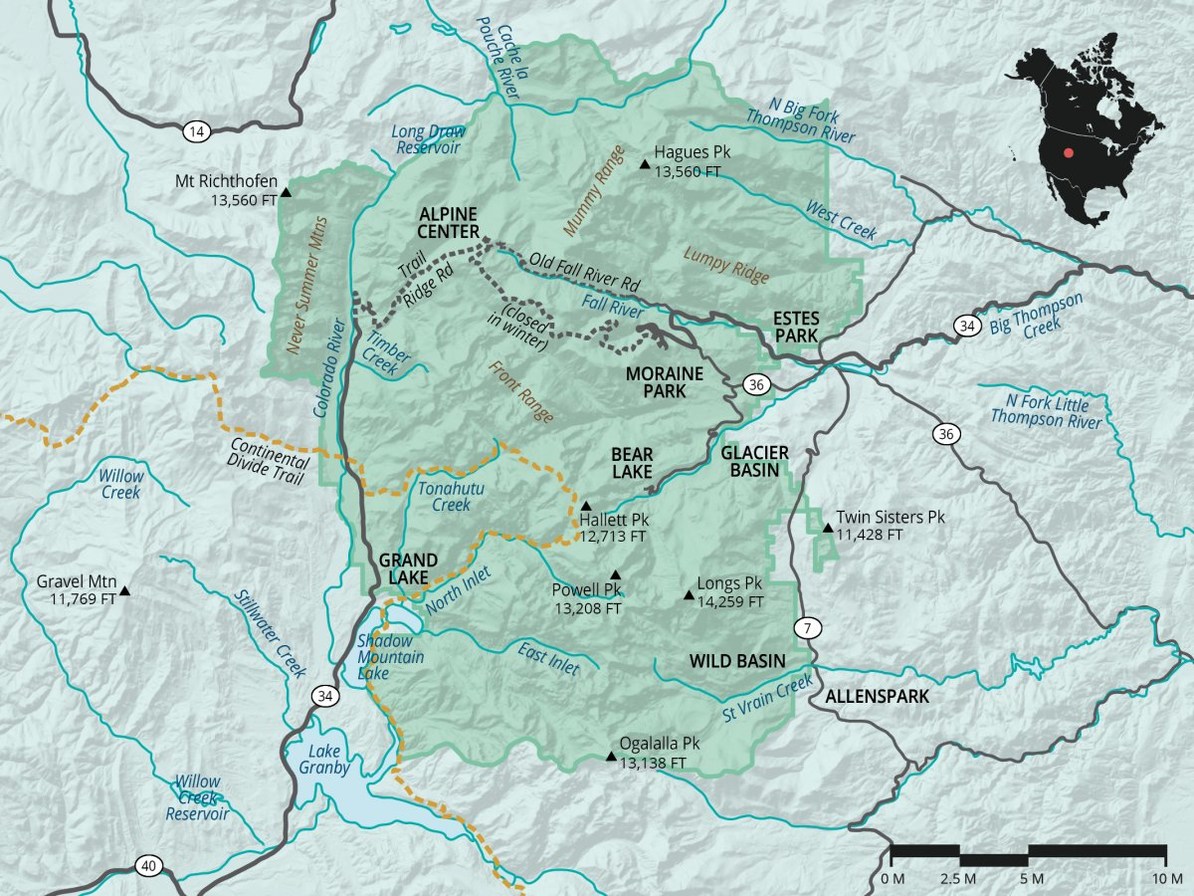
From its high glacial snow fields, rounded cirques, and jagged mountain peaks to its placid lakes and stunning montane forests, Rocky Mountain National Park is a territory of extraordinary beauty on a grand scale. The park encompasses over 400 square miles of Colorado’s Front Range, which juts up suddenly at the western edge of the Great Plains to create one of the most scenic and dramatic alpine areas in the country.
Within Rocky Mountain National Park’s boundaries visitors can explore nearly 360 miles of hiking trails that range from very accessible, casual day hikes to arduous and rewarding treks up to any number of incredible peaks; with more than 70 peaks above 12,000 feet, this area is truly a paradise for fans of alpine ascent. And while the interior of the park is a wild and rugged haven for those who are willing to commit to extended hikes, famous roads such as Trail Ridge Road and Bear Lake Road, which brings visitors within a short hike of several alpine lakes, ensure that families will enjoy direct access to this stunning American landscape as well. This access and variety are some of the reasons why Rocky Mountain National Park remains such a popular destination and the nation’s fifth-most visited national park, with more than 3.4 million visitors in 2014.
Many choose to access Rocky Mountain National Park through the small town of Estes Park on the eastern side, which is just an hour and a half by car from Denver International Airport. It was in Estes Park that Enos Mills, known as the “Father of Rocky Mountain National Park,” set up his homestead. Mills had come to the Rockies from Kansas to help his tuberculosis, and the area soon became a passion for him. A fortuitous meeting with John Muir in San Francisco kindled a career-like focus on advocacy and preservation that was instrumental in moving Congress to pass the 1915 legislation creating the park. Estes Park is also home to another key role player in the park’s designation: the Stanley Hotel, which was an elegant outpost for a well-to-do class of tourists from the east. Given the political struggles conservationists such as Mills and the Sierra Club faced on their quest to get the land officially designated as a national park, the alliance of wealthy tourists and Stanley Hotel alumni who were able to bring their enthusiasm, influence, and support back to the east coast was critical. With proximity to an abundance of lodging options in Estes Park, Boulder, and the smaller town of Grand Lake, many visitors choose to come as day visitors.
Because of these fortunate alignments, visitors have enjoyed an area that has remained largely unchanged for the last 100 years as the human impact on the surrounding land has grown. Those who summit the park’s iconic 14,259-foot Longs Peak or any of the other more accessible summits in the park can look back in time at a geologic formation that is truly unique in the history of the continent. These mountains were actually generated from a continuation of the subduction process that created prominent West Coast ranges more than a thousand miles away. Incredibly, the Pacific plates that had been forced downward beneath the North American plates gradually migrated toward the earth’s surface as they moved inland approximately 70 million years ago, exerting upward pressure on the crust from below. This uplift pushed the 1.7-billion-year-old Precambrian basement granite to the surface and created the peaks of the Front Range and much of the southern Rockies. Valuable minerals near the earth’s surface and within striking distance of any number of mining operations are, of course, an essential part of Colorado’s history and economy; in a range that includes several examples of mountaintops that have been leveled for resource extraction outside of Rocky Mountain National Park, the work of Mills and countless others that helped to set these mountains aside for protection should not be underestimated.
This century of protection has ensured the health of a diverse alpine ecosystem. The lower montane forests of pondorosa pines, Douglas firs, and aspens, which are justifiably famous for their magnificent displays of annual autumnal splendor, top out around 9,000 feet, when spruce and subalpine fir take over. Tree line in the park falls around 11,500 feet, which means that hikers have the opportunity to explore a huge portion of the park with expansive views of the surrounding peaks and, importantly, much greater exposure to the elements. Indeed, anyone exploring Rocky Mountain National Park should be aware of how quickly and how consistently high-elevation storm systems can sweep in. Hot, humid air from the lower elevation Great Basin moves westward and upward, rapidly condensing as it hits the Front Range into thunderstorms that can reach an enormous magnitude. It is conventional wisdom and a common practice for hikers to be down from the higher elevation destinations by early afternoon to avoid lightning and exposure risks. Blizzards are commonplace in the winter, and sudden temperature drops are to be expected. Skiers and snowshoers should be prepared for the worst to safely enjoy the best of the park in winter. Because the Continental Divide runs through Rocky Mountain National Park, the character of these storms may differ depending on the direction of their approach: storms from the east may have higher winds and lower temperatures, whereas storms from the west may drop more snow with less bluster.
Though the park is significantly smaller than the original vision Enos Mills had in mind (a political concession to mining interests at the time), the size and diversity of the area still warrants a little planning before you arrive. We’ve divided the park into seven areas loosely based on geographical features and popular access points. As is the case with many national parks, a person could spend years exploring this place and still discover new things about the park and themselves; that said, it is very easy to put together a reasonable itinerary that will provide you with incredible memories, photographs, and a powerful desire to return for more.
Southeast + Longs Peak
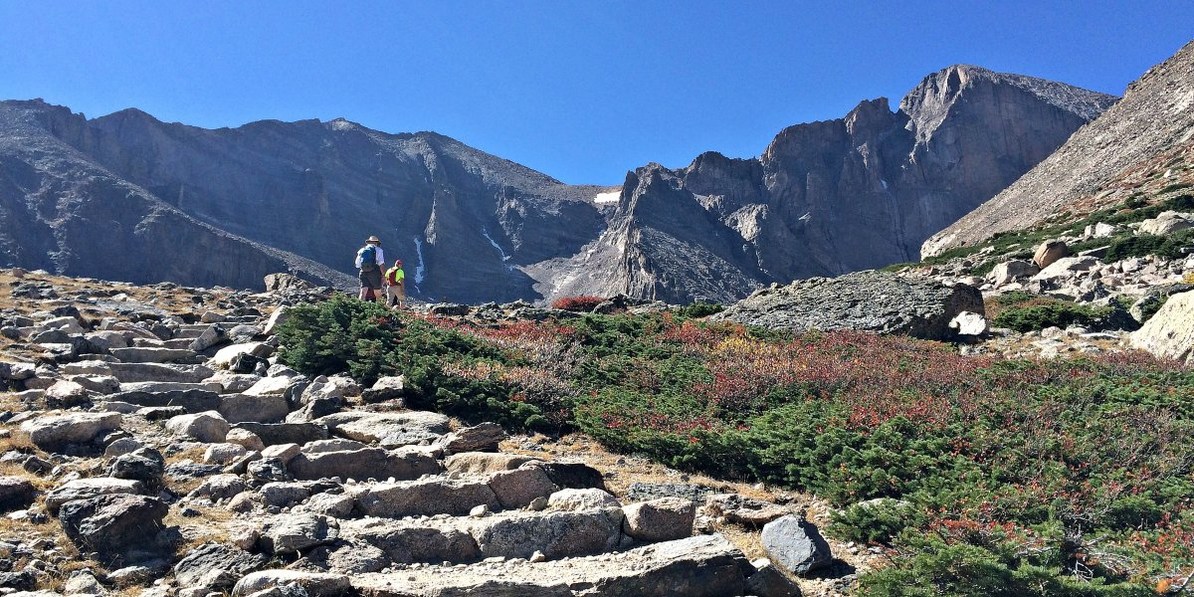
View of Mount Meeker (13,911') and Longs Peak (14,249') en route to Chasm Lake. Photo by Justin Michael.
This popular corner of the park is dominated by the string of peaks marking the Continental Divide as it moves north out of the Indian Peaks Wilderness. Several 13ers lie in this chain, which culminates in the 14,259-foot Longs Peak, the park’s tallest peak. Thousands of people attempt the arduous climb up Longs Peak annually, and the park service posts current conditions and webcam images in an effort to ensure only the prepared undertake the adventure. But this section of the park is also home to an abundance of gorgeous, must-see alpine lakes and meadows that are easily accessible from the Wild Basin and Longs Peak trailheads, as well. This area also shines in winter when ice climbers come for frozen falls and snowshoers and skiers tour the frozen lakes.
- Longs Peak via the Keyhole Route: The national park's most icon and demanding hike, gaining 5,100 feet.
- Longs Peak Campground: Ideal for Longs Peak ascents and plenty of additional hikes in the area.
- Eugenia Mine Hike: A defunct gold mine easily accessible from the Longs Peak Trail.
- Ouzel Falls Hike: A short hike that follows the water leads to these beautiful falls.
- Chasm Lake Hike: Amazing views directly below Longs Peak.
- Olive Ridge Campground: Largest campground for the southeast portion of the park tucked away under a grove of ponderosa pines.
- Meeker Park Overflow Campground: Primitive campground ideal if everything else is already booked.
- Allenspark Lodge: The area's most charming accommodation, however children under 14 are not permitted.
Bear Lake + Moraine Park Area
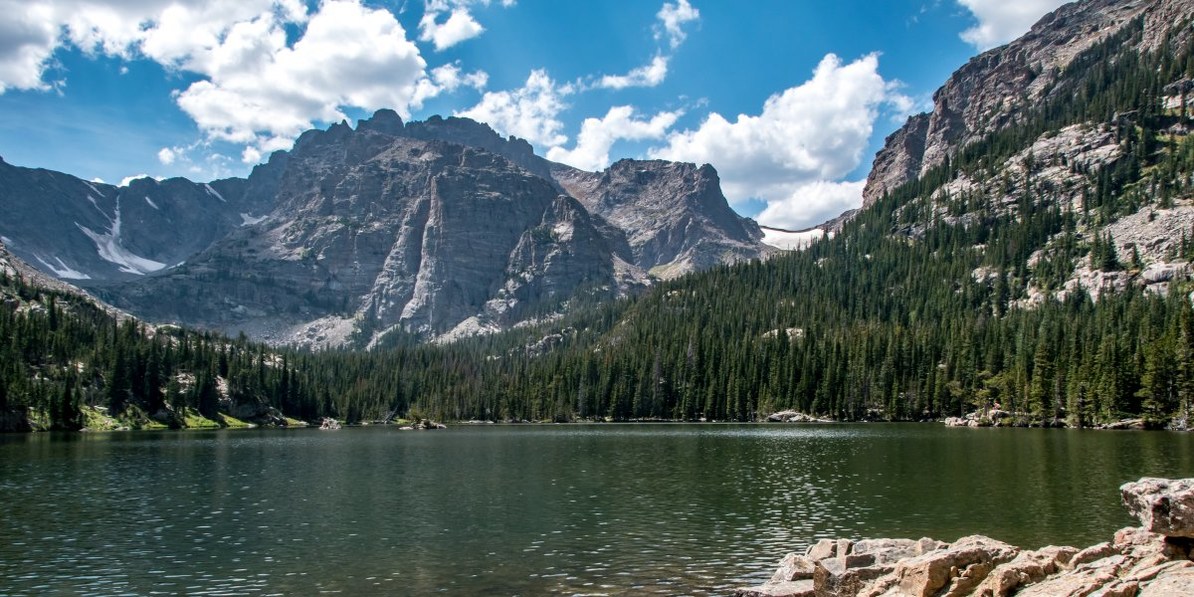
View of Taylor Peak (13,153') from The Loch. Photo by Denis LeBlanc.
In many ways the heart of Rocky Mountain National Park, the Bear Lake and Moraine Park Area are connected by the Bear Lake Road artery. Near Moraine Park you’ll have access to the wide open meadows and languorous Big Thompson River threads that fill the basin. Hikes from the Fern Lake and Cub Lake Trailheads can easily become short loops or longer one-way hikes with a shuttle. Farther along Bear Lake Road you’ll find the Bierstadt Lake Trailhead, while the end of the road is only the beginning of several popular and accessible hikes to alpine lakes. If you are searching for quick trips into a variety of alpine lakes, this is a great area to spend some time.
- The Loch Hike: A beautiful hike with rewarding views of Sharkstooth.
- Andrews Glacier: A more challenging hike beyond The Loch toward one of only 16 active glaciers in Colorado.
- Sprague Lake Loop Hike: A perfect hike for the family around this picturesque lake.
- Bear Lake Loop Hike: Spectacular views along this very short hike around Bear Lake.
- Bierstadt Lake: A 3-mile loop that is a great alternative for a less crowded hike in the park.
- Twin Sisters Peak Hike: A half-day hike with moderate elevation gain that yields expansive views of the park.
- Lily Lake Loop Hike: Close to Estes Park and a great spot for family exploration.
- Nymph, Dream + Emerald Lakes Hike: The most popular hike in the park, and for very good reason.
- Emerald Lake Backcountry Tour: This tour provides excellent views of the park and a variety of terrain for skiers and snowboarders of all abilities.
- Lake Haiyaha Hike: A must-do hike if you are exploring Dream Lake.
- The Pool + Cub Lake Loop Hike: A perfect short hike if you are staying near the Moraine Park Campground.
- Moraine Park Campground: The largest campground in the park is open year round and conveniently located near several trailheads and beautiful views.
- Glacier Basin Campground: A great location near several trails, including Sprague Lake.
- Bear Lake to Fern Lake: This 10-mile hike leaves from Bear Lake Road and features a look at Odessa Lake, Fern Lake, and Lake Helene.
- Flattop Mountain and Hallet Peak: This climb is a good choice for beggining mountaineers and those just getting used to climbing steeper routes in snow. The route uses the Flattop Gully Couloir to access the summit of Flattop Mountain, and from there Hallet Peak is an additional 700-foot climb.
Trail Ridge Road
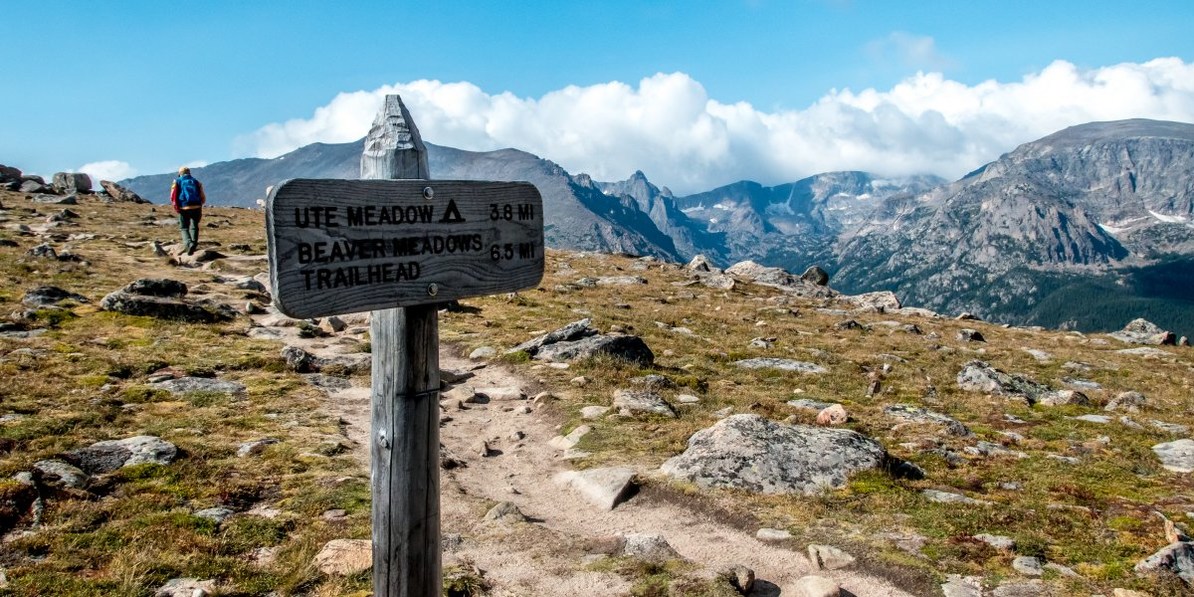
High on the Ute Trail off of Trail Ridge Road. Photo by Denis LeBlanc.
Highway 34, known as Trail Ridge Road, crosses the park from east entrances of Fall River and Beaver Meadows to the west entrance at Grand Lake. Along the way this road tops out at an impressive 12,183 feet and spends 11 miles above tree line, providing phenomenal Rocky Mountain views. This road passes some of the most beautiful vistas in the park, not to mention excellent trails that wind through the alpine tundra high above the Big Thompson and Fall River drainages. Just be sure not to let the scenery distract you from the steep grade and tight turns along this route; take your time, use the turn-outs, and enjoy the access that one of the country’s highest paved roads provides. As you may expect, Trail Ridge Road closes in the winter, so be sure to check road conditions if you are planning a visit in the off season.
- Peak 12,150 Hike: Brilliant views of Mount Ida and the Cache la Poudre River Valley below.
- Alpine Ridge Trail Hike: A short walk from the visitor center yields even better views of the high country.
- Ute Trail Hike to Timberline Pass: Choose a quick turnaround at Timberline or set a shuttle for a longer tour along the ridge.
- Many Parks Curve Overlook: A quintessential stop along your tour of one of the highest paved roads in the country.
Estes Park, Lumpy Ridge + Fall River
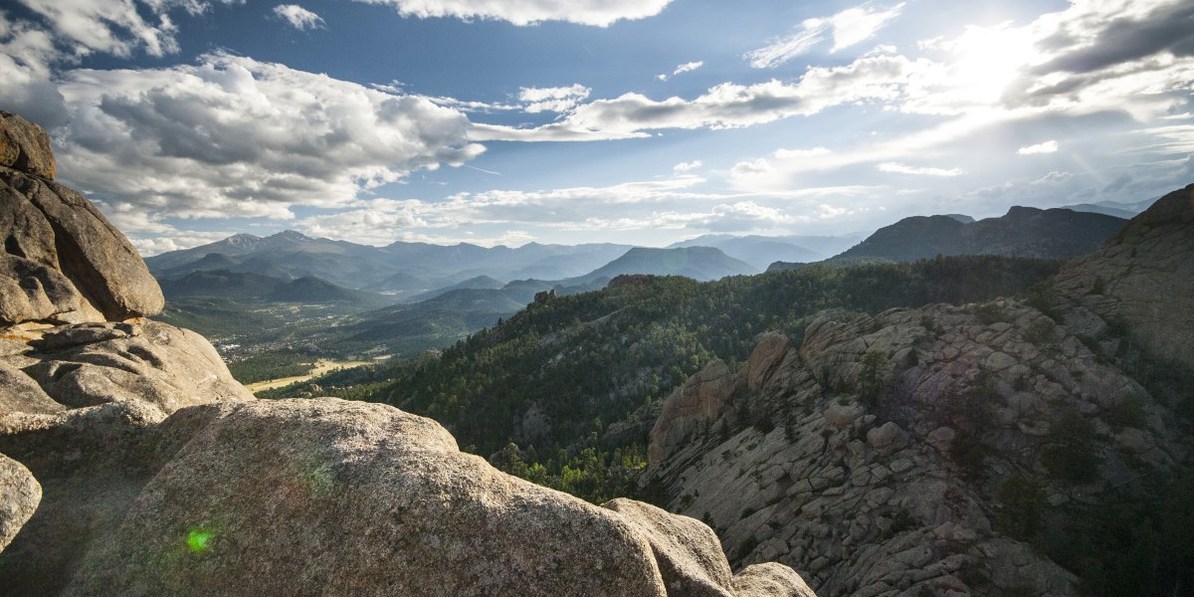
View south of Rocky Mountain National Park from Lumpy Ridge near Gem Lake. Photo by Tyson Gillard.
Estes Park is the gateway to Rocky Mountain National Park, and it is from here that visitors generally choose either to enter at the Beaver Meadows Entrance Station for access to Moraine Park or to head farther north to the Fall River Entrance Station and Aspenglen. The Fall River corridor is the eastern end of Trail Ridge Road, and if you arrive in season you can continue west along Old Fall River Road for excellent access to the trail leading up the Roaring River or Chapin Creek. This road is older and rougher than Trail Ridge, so be sure to check road conditions. Lumpy Ridge, located just inside the park boundaries and visible from Estes Park, is home to some of the park's most phenomenal rock climbing crags and has an extended trail systems that circumnavigate the feature; this northeast section is also easily accessed via Devils Gulch Road that leaves from Estes Park.
- Old Fall River Road: The first major road into the park is still a beautiful route to tour.
- Gem Lake Hike via Lumpy Ridge Trailhead: A short, steep hike to some extraordinary alpine terrain, this hike is worth the effort.
- Lumpy Ridge: A beautiful 10-mile loop that allows for views of Gem Lake and Bridal Veil Falls.
- Aspenglen Campground: An ideal base camp for your explorations of the Fall River and Big Thompson River drainages.
- Stanley Hotel: Iconic 1909 historic Colonial Revival hotel with plenty of comforts.
- Bridal Veil Falls via Cow Creek Trail: Follow Cow Creek as it passes through fields of wildflowers, pockets of dense forest, and all the way up to its dramatic plunge at Bridal Veil Falls. Moderate ascent and distance make this a good option for families.
- Bluebird Lake: This 12-mile hike gains 2,500 feet and features Copeland Falls, Calypso Cascades, Ouzel Falls, Ouzel Lake, and finishes with Bluebird Lake. Definitely worth the work!
Mummy Range
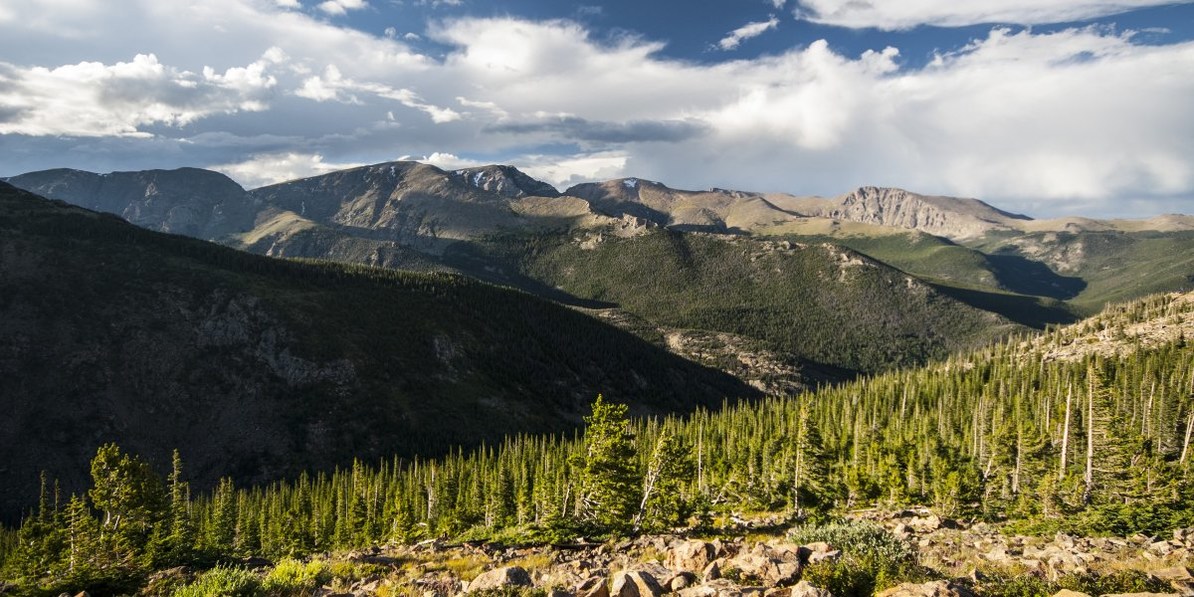
View north of the Mummy Range from the Trail Ridge Road. Photo by Tyson Gillard.
The Mummy Range shoots up from the Fall River drainage in a northeasterly arc that includes several prominent 13ers and some of the parks most beautiful alpine lakes. Best accessed via longer trails such as the Lawn Lake Trail, the Mummy Pass Trail, and the North Fork Trail, or via Chapin or Hague creeks, this country takes a little more work to enter, and it is absolutely worth every step. Catch a sunrise reflected off the face of Ypsilon Mountain or Hagues Peak, enjoy a multi-day escapade up the North Fork of the Big Thompson, or admire Mummy Mountain’s escarpment from Lawn Lake. This northern sub-range is one of Rocky Mountain National Park’s gems.
- Ypsilon Lake: A 9-mile round-trip hike with 2,180 feet of elevation gain leads to this forested lakeshore with amazing views.
- Lawn Lake: At just over 12 miles round-trip with 2,200 feet of elevation gain, this hike puts you just below Mummy Mountain.
- Chapin, Chiquita + Ypsilon (CCY Route): This hike takes you to the summits of Mount Chapin, Mount Chiquita, and Ypsilon Mountain for incredible views of Rocky Mountain National Park. Be prepared for some significant elevation gain, and be sure to start early on this big hike.
Never Summer Mountains
Another sub-range in Rocky Mountain National Park, the Never Summer Mountains are where the Continental Divide makes an unusual gooseneck on itself. This means that one can stand on any of the 12,000-foot summits that constitute the northwestern edge of Rocky Mountain National Park and look east toward the Colorado River, a Pacific waterway, and west toward drainages that will end up in the Gulf of Mexico via the Platt and Missouri rivers. As the name may imply, this range is popular for winter backcountry recreation, though summer hiking is fantastic as well. A hike up to Lake of the Clouds for stirring views of Mount Cirrus is sure to nourish your soul.
- Lulu City: A short, pretty hike to this former town that was more a dream than a reality.
- Lake of the Clouds: Roughly 7 miles and 2,300 feet of elevation gain from the Colorado River Trailhead gets you right in the heart of the Never Summers.
- Skeleton Gulch: Past Lulu City, this dramatic drainage sits at the northern end of park's portion of the Never Summer Range.
- Little Yellowstone via the La Poudre Pass Trail: The trail starts at the Colorado River Trailhead and leads past the ruins of historic cabins, Lulu City, and through the beautiful Kawuneeche Valley before rising into the white canyons of the Little Yellowstone area.
Westside
Dominated by the mellow, open meadows of Kawuneeche Valley, this aspect of the park is a wonderful juxtaposition to the higher elevation tundra along the higher sections of Trail Ridge Road and barren granite peaks of the Never Summer Mountains. Come here in summer for lush green grass, robust montane forests, and a vibrant cross section of wildlife. Enjoy a hike to Long Meadows from the Timber Creek Trailhead for more alpine meadow views. The stretch of Highway 34 between Timber Creek and the Grand Lake Entrance Station passes the Onahu Trailhead, the Bowen/Baker Trailhead for Bowen and Baker gulches (both leaving the park), and the remarkable Continental Divide Trail. And last but certainly not least, if you are looking to spend some time exploring the Paradise Park area, a multi-day trip on the East Inlet Trail to Spirit Lake can’t be passed up.
- Big Meadows: Leaves from the Green Mountain Trailhead, this 1.8-mile one-way walk pays off with rewarding views.
- Cascade Falls: This 7-mile round-trip hike from the North Inlet Trailhead is a great way to see Summerland Park.
- Spirit Lake: Perhaps best enjoyed as multi-day trip that leaves from the East Inlet Trailhead that leads to a chain of alpine lakes.
- Timber Creek Campground: This 98-site, first-come, first-served campground is the only one on the park's west side actually located within the boundaries, and it is open year round with seasonal water supply.
- Green Ridge Campground: Located on the south end of Shadow Mountain Lake (Reservoir) with 78 non-utility sites.
- Stillwater Campground: Located on the western shore of Lake Granby (Reservoir) features 129 campsites with 21 having an electrical hook-up.
- Sunset Point Campground: On Lake Granby's southern shore with 25 non-utility sites.
Backpacking + Climbing
A Leave No Trace ethic is absolutely imperative for any visitor to Rocky Mountain National Park. Backcountry users need to pack out their garbage and properly dispose of any waste, travel on durable surfaces when available, use existing campsites, and skip the campfire unless absolutely necessary and permitted. Rocky Mountain National Park is a national treasure that should be celebrated and enjoyed responsibly.
All overnight trips on trails or in the backcountry require permits that are available in person at either the Beaver Meadows Visitor Center or the Kawuneeche Visitor Center. There are 120 backcountry campsites in Rocky Mountain National Park, so with a little research you are sure to find an ideal spot for your extended trips. Bears are commonplace in the park, so bear-resistant food containers are common sense in all seasons and required between May 1 and October 31. Call 970.586.1242 for more information.
While no special permits are required for day use climbs, bivouac permits are required for multi-day, multi-pitch climbs more than 3.5 miles from a trailhead. For the most part, climbers are able to dictate their own schedule, routes, and objectives. One critical note for all climbers, however, is that minimum impact climbing practices must be practiced at all times. Bolts and pitons are unacceptable, and motorized drills are prohibited. The incredible mountain habitat that draws climbers is also a natural fit for raptors, so certain areas will be off limits during nesting season.
Weather + Lightning Storms
If you'll be backpacking or climbing within the park it is extremely critical to note that summer weather brings strong rain and lightning storms nearly every afternoon, making it necessary to be off the trail by at least 1 p.m. daily to assure a safe return. Mornings may have clear skies, but they are no indication of afternoon storms.
Pets
Pets are permitted within the park's developed areas and within all established campgrounds, but they must be kept on leashes at all times. Pets are not permitted, however, on any of the trails or any undeveloped areas.
Logistics + Planning
Current Weather: Powered by Dark Sky








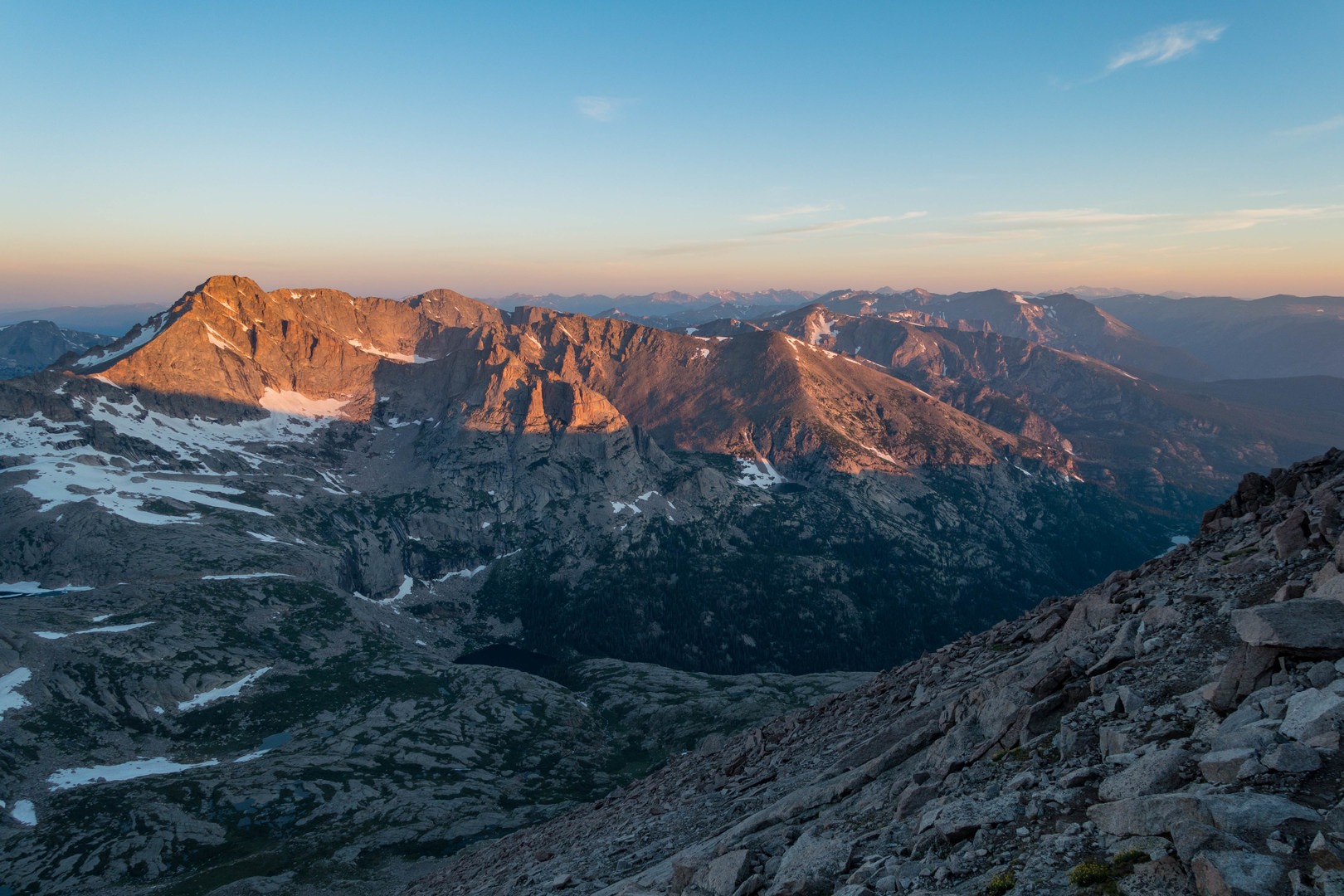


















Comments
Sign In and share them.